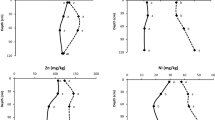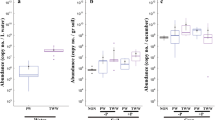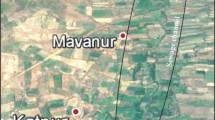Abstract
The scarcity of water in semiarid regions requires alternative sources for irrigation to improve agricultural production. Here, we aimed to evaluate the effects of produced water from oil exploration on the structure of soil mesofauna during the dry and rainy seasons in irrigated sunflower and castor bean fields in a Brazilian semiarid region. Three irrigation treatments were applied on plots cultivated with castor beans and sunflowers: produced water treated by filtration (filtrated) or treated by reverse osmosis (reverse osmosis) and groundwater. The mesofauna under the biofuel crops was collected and identified during the dry and rainy seasons. Although the abundance and richness of the total fauna did not differ between seasons in sunflower plots, the community was altered. In castor beans, the abundance, richness, and community of mesofauna observed in plots irrigated with produced water differed from the groundwater treatment. Irrigation with produced water promotes important changes in soil fauna community that justify their assessment for the maintenance and monitoring of agroecosystems.


Similar content being viewed by others
References
Acosta-Martínez, V., Cotton, J., Gardner, T., Moore-Kucera, J., Zak, J., Wester, D., & Cox, S. (2014). Predominant bacterial and fungal assemblages in agricultural soils during a record drought/heat wave and linkages to enzyme activities of biogeochemical cycling. Applied Soil Ecology, 84, 69–82. doi:10.1016/j.apsoil.2014.06.005.
Al-Haddabi, M., & Ahmed, M. (2007). Land disposal of treated saline oil production water: impacts on soil properties. Desalination, 212(1–3), 54–61. doi:10.1016/j.desal.2006.09.019.
Allen, R. M., & Robinson, K. (1993). Environmental aspects of produced water disposal. In Proceedings of Middle East oil show (pp. 1–16). Bahrain: Society of Petroleum Engineers. doi:10.2118/25549-MS.
Bachar, A., Al-Ashhab, A., Soares, M. I. M., Sklarz, M. Y., Angel, R., Ungar, E. D., & Gillor, O. (2010). Soil microbial abundance and diversity along a low precipitation gradient. Microbial Ecology, 60(2), 453–61. doi:10.1007/s00248-010-9727-1.
Bedano, J. C., Cantú, M. P., & Doucet, M. E. (2006). Influence of three different land management practices on soil mite (Arachnida: Acari) densities in relation to a natural soil. Applied Soil Ecology, 32(3), 293–304. doi:10.1016/j.apsoil.2005.07.009.
Bedano, J. C., & Ruf, A. (2007). Soil predatory mite communities (Acari: Gamasina) in agroecosystems of Central Argentina. Applied Soil Ecology, 36(1), 22–31. doi:10.1016/j.apsoil.2006.11.008.
Berg, M., De Ruiter, P., Didden, W., Janssen, M., Schouten, T., & Verhoef, H. (2001). Community food web, decomposition and nitrogen mineralisation in a stratified Scots pine forest soil. Oikos, 94(1), 130–142. doi:10.1034/j.1600-0706.2001.09121.x.
Berg, M. P. (2010). Spatio-temporal structure in soil communities and ecosystem processes. In H. A. Verhoef & P. J. Morin (Eds.), Community ecology: processes, models, and applications (pp. 69–79). New York: Oxford University Press. doi:10.1093/acprof:oso/9780199228973.003.0007.
Bezemer, T. M., Fountain, M. T., Barea, J. M., Christensen, S., Dekker, S. C., Duyts, H., et al. (2010). Divergent composition but similar function of soil food webs of individual plants: plant species and community effects. Ecology, 91(10), 3027–36.
Bosch-Serra, À. D., Padró, R., Boixadera-Bosch, R. R., Orobitg, J., & Yagüe, M. R. (2014). Tillage and slurry over-fertilization affect oribatid mite communities in a semiarid Mediterranean environment. Applied Soil Ecology, 84, 124–139. doi:10.1016/j.apsoil.2014.06.010.
Crossley, D. A., Mueller, B. R., & Perdue, J. C. (1992). Biodiversity of microarthropods in agricultural soils: relations to processes. Agriculture, Ecosystems & Environment, 40(1–4), 37–46. doi:10.1016/0167-8809(92)90082-M.
Cutz-Pool, L. Q., Palacios-Vargas, J. G., Castaño-Meneses, G., & García-Calderón, N. E. (2007). Edaphic collembola from two agroecosystems with contrasting irrigation type in Hidalgo State, Mexico. Applied Soil Ecology, 36(1), 46–52. doi:10.1016/j.apsoil.2006.11.009.
De Ruiter, P. C., Neutel, A. M., & Moore, J. C. (1994). Modelling food webs and nutrient cycling in agro-ecosystems. Trends in Ecology & Evolution, 9(10), 378–83. doi:10.1016/0169-5347(94)90059-0.
De Ruiter, P. C., Neutel, A. M., & Moore, J. C. (1995). Energetics, patterns of interaction strengths, and stability in real ecosystems. Science (New York, N.Y.), 269(5228), 1257–60. doi:10.1126/science.269.5228.1257.
Dejoia, A. J. (2002). Developing sustainable practices for CBM-produced water irrigation. The national association of state groundwater agencies. http://www.gwpc.org/meetings/special/PW2002/Papers/Aaron_DeJoia_PWC2002.pdf. Accessed 18 Feb 2012.
Domínguez, A., Bedano, J. C., Becker, A. R., & Arolfo, R. V. (2013). Organic farming fosters agroecosystem functioning in Argentinian temperate soils: evidence from litter decomposition and soil fauna. Applied Soil Ecology. doi:10.1016/j.apsoil.2013.11.008.
Elkins, N. Z., & Whitford, W. G. (1984). The effects of high salt concentration on desert soil microarthropod density and diversity. Southwestern Naturalist, 30(2), 239–241.
Ettema, C., & Wardle, D. A. (2002). Spatial soil ecology. Trends in Ecology & Evolution, 17(4), 177–183. doi:10.1016/S0169-5347(02)02496-5.
Ferreira, R. N. C., Franklin, E., de Souza, J. L. P., & de Moraes, J. (2012). Soil oribatid mite (Acari: Oribatida) diversity and composition in semi-deciduous forest fragments in eastern Amazonia and comparison with the surrounding savanna matrix. Journal of Natural History, 46(33–34), 2131–2144. doi:10.1080/00222933.2012.707245.
Frampton, G. K., Van den Brink, P. J., & Gould, P. J. (2000). Effects of spring precipitation on a temperate arable collembolan community analysed using principal response curves. Applied Soil Ecology, 14(3), 231–248. doi:10.1016/S0929-1393(00)00051-2.
Franklin, E., Magnusson, W. E., Luizao, F., & Luizão, F. J. (2005). Relative effects of biotic and abiotic factors on the composition of soil invertebrate communities in an Amazonian savanna. Applied Soil Ecology, 29(3), 259–273. doi:10.1016/j.apsoil.2004.12.004.
Franklin, E., & Morais, J. W. (2006). Soil mesofauna in Central Amazon. In F. M. S. Moreira, J. O. Siqueira, & L. Brossaard (Eds.), Soil biodiversity in Amazonian and other Brazilian ecosystems (Vol. 78, pp. 142–162). Wallingford: CABI Publishing.
Ibekwe, A. M., Poss, J. A., Grattan, S. R., Grieve, C. M., & Suarez, D. (2010). Bacterial diversity in cucumber (Cucumis sativus) rhizosphere in response to salinity, soil pH, and boron. Soil Biology and Biochemistry, 42(4), 567–575. doi:10.1016/j.soilbio.2009.11.033.
Janke, S., Schamber, H., & Kunze, C. (1992). Effects of heating oil on the soil biological activity. Angewandte Botanik, 66, 42–45.
Johnston, C. R., Vance, G. F., & Ganjegunte, G. K. (2008). Irrigation with coalbed natural gas co-produced water. Agricultural Water Management, 95(11), 1243–1252. doi:10.1016/j.agwat.2008.04.015.
Köck-Schulmeyer, M., Ginebreda, A., Postigo, C., López-Serna, R., Pérez, S., Brix, R., et al. (2011). Wastewater reuse in Mediterranean semi-arid areas: the impact of discharges of tertiary treated sewage on the load of polar micro pollutants in the Llobregat river (NE Spain). Chemosphere, 82(5), 670–678. doi:10.1016/j.chemosphere.2010.11.005.
Lalley, J. S., Viles, H. A., Henschel, J. R., & Lalley, V. (2006). Lichen-dominated soil crusts as arthropod habitat in warm deserts. Journal of Arid Environments, 67(4), 579–593. doi:10.1016/j.jaridenv.2006.03.017.
Leung, H. W. (2001). Ecotoxicology of glutaraldehyde: review of environmental fate and effects studies. Ecotoxicology and Environmental Safety, 49(1), 26–39. doi:10.1006/eesa.2000.2031.
Lindberg, N., Engtsson, J. B., & Persson, T. (2002). Effects of experimental irrigation and drought on the composition and diversity of soil fauna in a coniferous stand. Journal of Applied Ecology, 39(6), 924–936. doi:10.1046/j.1365-2664.2002.00769.x.
Lopes, E. D. O. R., Weber, O. B., Crisóstomo, L. A., & de Mattos, E. P. N. B. (2014). Short-term effects of produced water on microbial activity in semiarid soil. International Journal of Current Microbiology and Applied Sciences, 3(2), 295–403.
MacKay, W. P., Silva, S. I., & Whitford, W. G. (1987). Diurnal activity patterns and vertical migration in desert soil microarthropods. Pedobiologia, 30, 65–71.
MacKay, W. P., Silva, S., Lightfoot, D. C., Inez Pagani, M., & Whitford, W. G. (1986). Effect of increased soil moisture and reduced soil temperature on a desert soil arthropod community. American Midland Naturalist, 116(1), 45–56.
Melo, M., Schluter, H., Ferreira, J., Magda, R., Júnior, A., & de Aquino, O. (2010). Advanced performance evaluation of a reverse osmosis treatment for oilfield produced water aiming reuse. Desalination, 250(3), 1016–1018. doi:10.1016/j.desal.2009.09.095.
Morón-Ríos, A., Rodríguez, M. Á., Pérez-Camacho, L., & Rebollo, S. (2010). Effects of seasonal grazing and precipitation regime on the soil macroinvertebrates of a Mediterranean old-field. European Journal of Soil Biology, 46(2), 91–96. doi:10.1016/j.ejsobi.2009.12.008.
Neff, J. M. (2002). Bioaccumulation in marine organisms: effect of contaminants from oil well produced water. Amsterdam: Elsevier.
Nielsen, U. N., Osler, G. H. R., van der Wal, R., Campbell, C. D., & Burslem, D. F. R. P. (2008). Soil pore volume and the abundance of soil mites in two contrasting habitats. Soil Biology and Biochemistry, 40(6), 1538–1541. doi:10.1016/j.soilbio.2007.12.029.
Noble, J. C., Whitford, W. G., & Kaliszweski, M. (1996). Soil and litter microarthropod populations from two contrasting ecosystems in semi-arid eastern Australia. Journal of Arid Environments, 32(3), 329–346. doi:10.1006/jare.1996.0027.
Pulliam, R. (1988). Sources, sinks, and population regulation. The American Naturalist, 132(5), 652–661.
Qadir, M., Boers, T., Schubert, S., Ghafoor, A., & Murtaza, G. (2003). Agricultural water management in water-starved countries: challenges and opportunities. Agricultural Water Management, 62(3), 165–185. doi:10.1016/S0378-3774(03)00146-X.
R Development Core Team. (2014). R: A language and environment for statistical computing. Viena: R Foundation for Statistical Computing.
Remén, C., Krüger, M., & Cassel-Lundhagen, A. (2010). Successful analysis of gut contents in fungal-feeding oribatid mites by combining body-surface washing and PCR. Soil Biology and Biochemistry, 42(11), 1952–1957. doi:10.1016/j.soilbio.2010.07.007.
Rietz, D., & Haynes, R. (2003). Effects of irrigation-induced salinity and sodicity on soil microbial activity. Soil Biology and Biochemistry, 35(6), 845–854. doi:10.1016/S0038-0717(03)00125-1.
Sampaio, E. V. S. B. (1995). In S. H. Bullock, H. A. Mooney, & E. Medina (Eds.), Seasonally dry tropical forests. Cambridge: Cambridge University Press. doi:10.1017/CBO9780511753398.
Schneider, K., & Maraun, M. (2005). Feeding preferences among dark pigmented fungal taxa (“Dematiacea”) indicate limited trophic niche differentiation of oribatid mites (Oribatida, Acari). Pedobiologia, 49(1), 61–67. doi:10.1016/j.pedobi.2004.07.010.
Tabatabaei, S. H., & Najafi, P. (2009). Effects of irrigation with treated municipal wastewater on soil properties in arid and semi-arid regions. Irrigation and Drainage, 58(5), 551–560. doi:10.1002/ird.449.
Travis, M. J., Weisbrod, N., & Gross, A. (2012). Decentralized wetland-based treatment of oil-rich farm wastewater for reuse in an arid environment. Ecological Engineering, 39, 81–89. doi:10.1016/j.ecoleng.2011.11.008.
Ukabi, S., Whitford, W. G., & Steinberger, Y. (2009). Faunal pedturbation effects on soil microarthropods in the Negev Desert. Journal of Arid Environments, 73(10), 907–911. doi:10.1016/j.jaridenv.2009.04.001.
Wallwork, J. A. (1972). Distribution patterns and population dynamics of the micro-arthropods of a desert soil in Southern California. Journal of Animal Ecology, 41(2), 291–310. doi:10.2307/3470.
Wardle, D. A. (2002). Communities and ecosystems: linking the aboveground and belowground components. In S. A. Levin & H. S. Horn (Eds.), Monographs in population biology (Vol. 34). Princeton: Princeton University Press.
Wardle, D. A., Yeates, G. W., Watson, R. N., & Nicholson, K. S. (1995). The detritus food-web and the diversity of soil fauna as indicators of disturbance regimes in agro-ecosystems. Plant and Soil, 170(1), 35–43.
Wardle, D., Yeates, G., Barker, G., & Bonner, K. (2006). The influence of plant litter diversity on decomposer abundance and diversity. Soil Biology and Biochemistry, 38(5), 1052–1062. doi:10.1016/j.soilbio.2005.09.003.
Whitford, W. (1988). Abiotic controls on the functional structure of soil food webs. Biology and Fertility of Soils, 8(1), 1–6. doi:10.1007/BF00260508.
Whitford, W. G., Freckman, D. W., Elkins, N. Z., Parker, L. W., Parmalee, R., Phillips, J., & Tucker, S. (1981). Diurnal migration and responses to simulated rainfall in desert soil microarthropods and nematodes. Soil Biology and Biochemistry, 13(5), 417–425. doi:10.1016/0038-0717(81)90087-0.
Acknowledgments
This study was financially supported by PETROBRAS. The authors thank CAPES (Coordenação de Aperfeiçoamento de Pessoal de Nível Superior) and Embrapa Agroindústria Tropical.
Author information
Authors and Affiliations
Corresponding author
Rights and permissions
About this article
Cite this article
Ferreira, R.N.C., Weber, O.B. & Crisóstomo, L.A. Produced water irrigation changes the soil mesofauna community in a semiarid agroecosystem. Environ Monit Assess 187, 520 (2015). https://doi.org/10.1007/s10661-015-4744-7
Received:
Accepted:
Published:
DOI: https://doi.org/10.1007/s10661-015-4744-7




